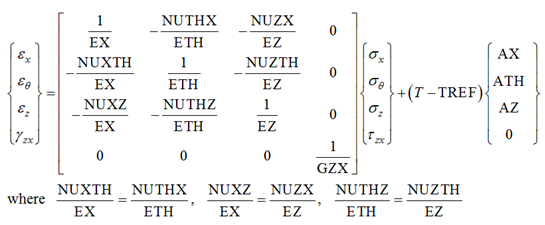MAT3 |

|

|

|

|
|
MAT3 |

|

|

|

|
Bulk Data Entry
MAT3 – Material Property Definition, Form 3
Defines the material properties for linear, temperature-independent, and orthotropic materials used by the CTAXI and CTRIAX6 axisymmetric elements.
Format
(1) |
(2) |
(3) |
(4) |
(5) |
(6) |
(7) |
(8) |
(9) |
(10) |
MAT3 |
MID |
EX |
ETH |
EZ |
NUXTH |
NUTHZ |
NUZX |
RHO |
|
|
|
|
GZX |
AX |
ATH |
AZ |
TREF |
GE |
|
|
Field |
Contents |
MID |
Unique material identification number. No default (Integer > 0) |
EX, ETH, EZ |
Young’s Moduli in the x, θ and z directions, respectively. No default (Real > 0.0) |
NUXTH, |
Poisson’s Ratios: NUXTH = Poisson’s Ratio for strain in the θ direction, when stress in the x direction. No default (Real) |
RHO |
Mass density. No default (Real) |
GZX |
Shear Modulus in the x-z plane. No default (Real > 0.0) |
AX, ATH, AZ |
Thermal expansion coefficient in the x, θ, and z directions, respectively. No default (Real) |
TREF |
Reference temperature for thermal loading. Default = blank (Real or blank) |
GE |
Structural element damping coefficient. See comment 6. No default (Real) |
| 2. | Values of all seven elastic constants, EX, ETH, EZ, NUXTH, NUTHZ, NUZX and GZX must be present. |
| 3. | A warning is issued if absolute value of NUXTH or NUTHZ is greater than 1.0. |
| 4. | The x, θ and z directions are principal material directions of the material coordinate system. Each element (that is a CTAXI or CTRIAX6 element) supporting the use of MAT3 contains a “Theta” field to relate the principal material directions to the basic coordinate system. |
| 5. | The strain-stress relationship is: |

Note that the strain and stress here are both defined in the material coordinate system.
| 6. | To obtain the damping coefficient GE, multiply the critical damping ratio, C/C0, by 2.0. |
| 7. | This card is represented as a material in HyperMesh. |
See Also:
Material Property Checks for MAT3